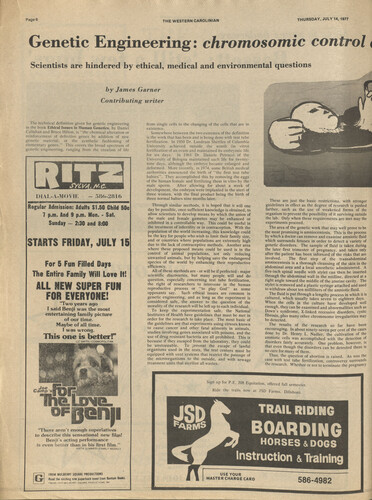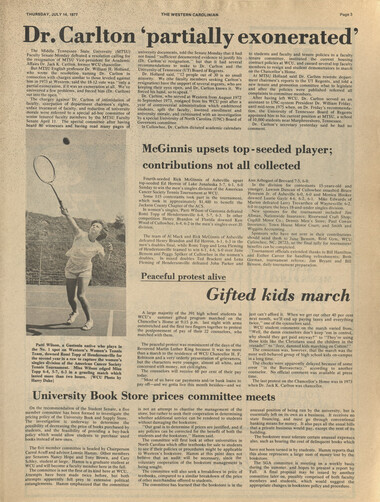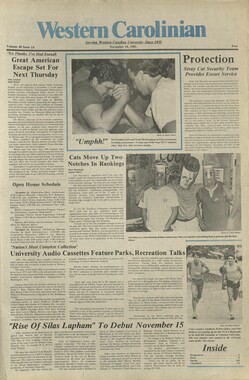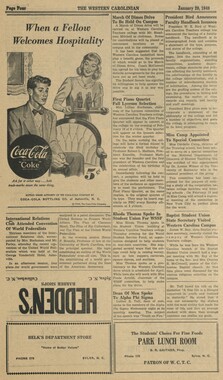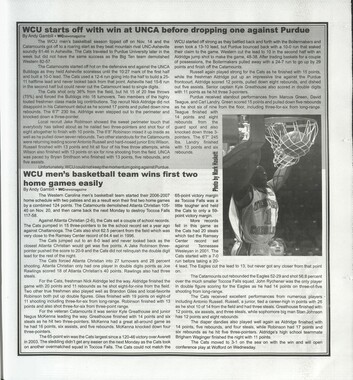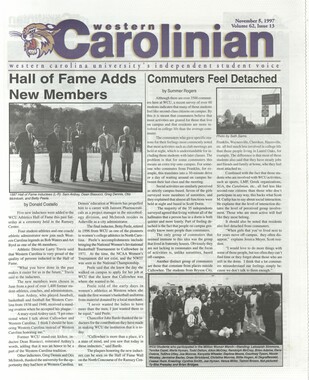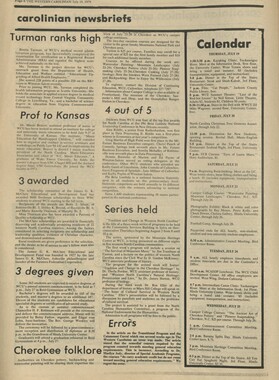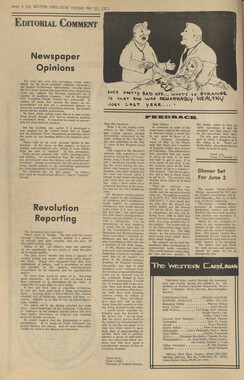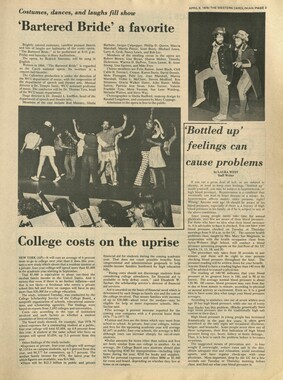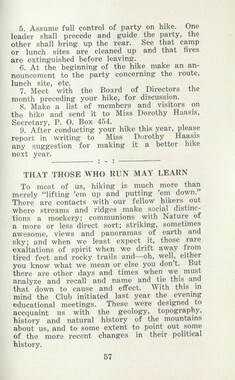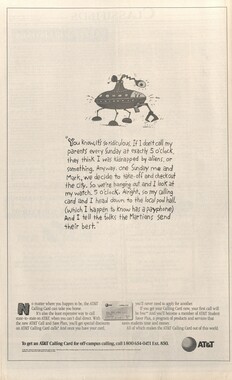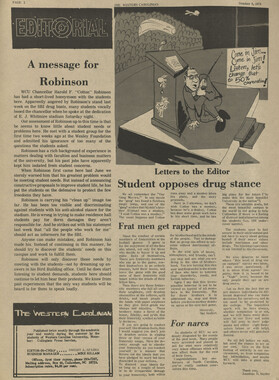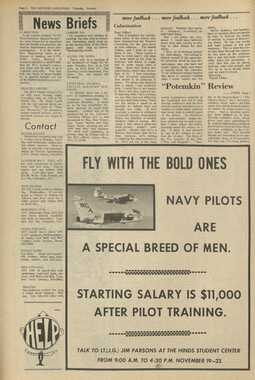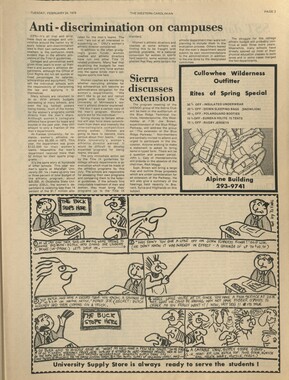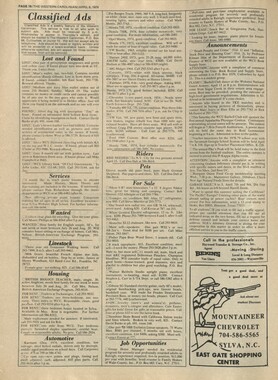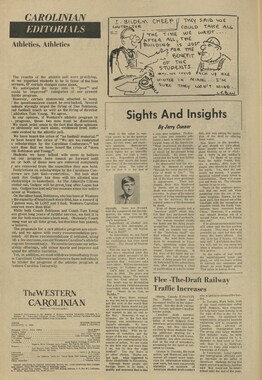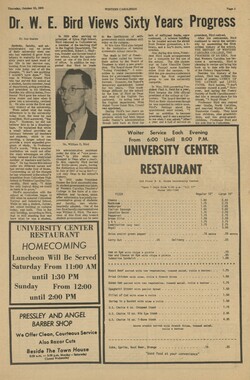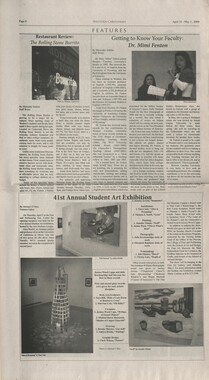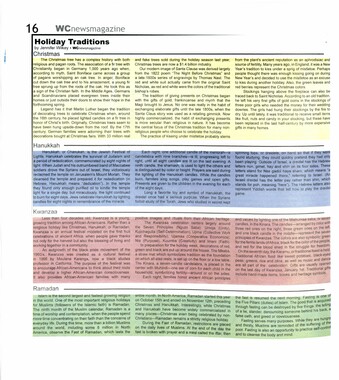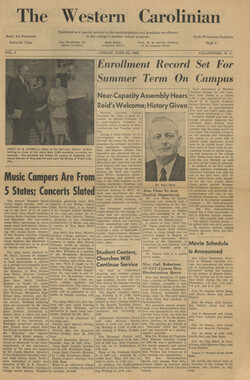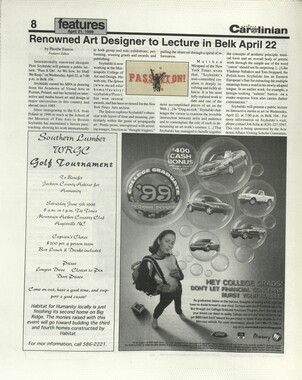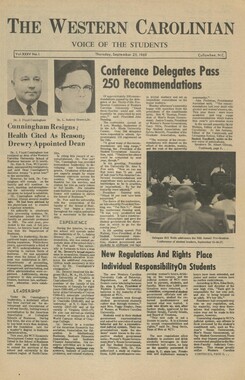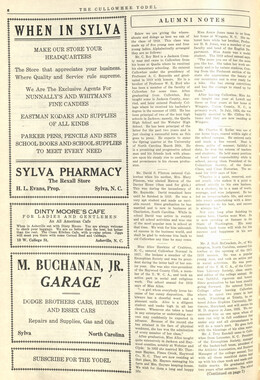Western Carolina University (21)
View all
- Canton Champion Fibre Company (2308)
- Cherokee Traditions (291)
- Civil War in Southern Appalachia (165)
- Craft Revival (1942)
- George Masa Collection (137)
- Great Smoky Mountains - A Park for America (2900)
- Highlights from Western Carolina University (422)
- Horace Kephart (973)
- Journeys Through Jackson (159)
- LGBTQIA+ Archive of Jackson County (85)
- Oral Histories of Western North Carolina (316)
- Picturing Appalachia (6797)
- Stories of Mountain Folk (413)
- Travel Western North Carolina (153)
- Western Carolina University Fine Art Museum Vitreograph Collection (129)
- Western Carolina University Herbarium (92)
- Western Carolina University: Making Memories (738)
- Western Carolina University Publications (2491)
- Western Carolina University Restricted Electronic Theses and Dissertations (146)
- Western North Carolina Regional Maps (71)
- World War II in Southern Appalachia (131)
University of North Carolina Asheville (6)
View all
- Allanstand Cottage Industries (62)
- Appalachian National Park Association (53)
- Bennett, Kelly, 1890-1974 (1463)
- Berry, Walter (76)
- Brasstown Carvers (40)
- Carver, George Washington, 1864?-1943 (26)
- Cathey, Joseph, 1803-1874 (1)
- Champion Fibre Company (233)
- Champion Paper and Fibre Company (297)
- Cherokee Indian Fair Association (16)
- Cherokee Language Program (22)
- Crowe, Amanda (40)
- Edmonston, Thomas Benton, 1842-1907 (7)
- Ensley, A. L. (Abraham Lincoln), 1865-1948 (275)
- Fromer, Irving Rhodes, 1913-1994 (70)
- George Butz (BFS 1907) (46)
- Goodrich, Frances Louisa (120)
- Grant, George Alexander, 1891-1964 (96)
- Heard, Marian Gladys (60)
- Kephart, Calvin, 1883-1969 (15)
- Kephart, Horace, 1862-1931 (313)
- Kephart, Laura, 1862-1954 (67)
- Laney, Gideon Thomas, 1889-1976 (439)
- Masa, George, 1881-1933 (61)
- McElhinney, William Julian, 1896-1953 (44)
- Niggli, Josephina, 1910-1983 (10)
- North Carolina Park Commission (105)
- Osborne, Kezia Stradley (9)
- Owens, Samuel Robert, 1918-1995 (11)
- Penland Weavers and Potters (36)
- Roberts, Vivienne (15)
- Roth, Albert, 1890-1974 (142)
- Schenck, Carl Alwin, 1868-1955 (1)
- Sherrill's Photography Studio (2565)
- Southern Highland Handicraft Guild (127)
- Southern Highlanders, Inc. (71)
- Stalcup, Jesse Bryson (46)
- Stearns, I. K. (213)
- Thompson, James Edward, 1880-1976 (226)
- United States. Indian Arts and Crafts Board (130)
- USFS (683)
- Vance, Zebulon Baird, 1830-1894 (1)
- Weaver, Zebulon, 1872-1948 (58)
- Western Carolina College (230)
- Western Carolina Teachers College (282)
- Western Carolina University (2008)
- Western Carolina University. Mountain Heritage Center (18)
- Whitman, Walt, 1819-1892 (10)
- Wilburn, Hiram Coleman, 1880-1967 (73)
- Williams, Isadora (3)
- Cain, Doreyl Ammons (0)
- Crittenden, Lorraine (0)
- Rhodes, Judy (0)
- Smith, Edward Clark (0)
- Appalachian Region, Southern (2940)
- Asheville (N.C.) (1944)
- Avery County (N.C.) (26)
- Blount County (Tenn.) (195)
- Buncombe County (N.C.) (1680)
- Cherokee County (N.C.) (283)
- Clay County (N.C.) (556)
- Graham County (N.C.) (238)
- Great Smoky Mountains National Park (N.C. and Tenn.) (525)
- Haywood County (N.C.) (3573)
- Henderson County (N.C.) (70)
- Jackson County (N.C.) (4919)
- Knox County (Tenn.) (35)
- Knoxville (Tenn.) (13)
- Lake Santeetlah (N.C.) (10)
- Macon County (N.C.) (421)
- Madison County (N.C.) (216)
- McDowell County (N.C.) (39)
- Mitchell County (N.C.) (135)
- Polk County (N.C.) (35)
- Qualla Boundary (982)
- Rutherford County (N.C.) (78)
- Swain County (N.C.) (2185)
- Transylvania County (N.C.) (270)
- Watauga County (N.C.) (12)
- Waynesville (N.C.) (86)
- Yancey County (N.C.) (72)
- Aerial Photographs (3)
- Aerial Views (60)
- Albums (books) (4)
- Articles (1)
- Artifacts (object Genre) (228)
- Bibliographies (1)
- Biography (general Genre) (2)
- Cards (information Artifacts) (38)
- Clippings (information Artifacts) (192)
- Copybooks (instructional Materials) (3)
- Crafts (art Genres) (622)
- Depictions (visual Works) (21)
- Design Drawings (1)
- Digital Moving Image Formats (2)
- Drawings (visual Works) (185)
- Envelopes (101)
- Exhibitions (events) (1)
- Facsimiles (reproductions) (1)
- Fiction (general Genre) (4)
- Financial Records (12)
- Fliers (printed Matter) (67)
- Glass Plate Negatives (381)
- Guidebooks (2)
- Internegatives (10)
- Interviews (817)
- Land Surveys (102)
- Letters (correspondence) (1045)
- Manuscripts (documents) (618)
- Maps (documents) (177)
- Memorandums (25)
- Minutes (administrative Records) (59)
- Negatives (photographs) (6090)
- Newsletters (1290)
- Newspapers (2)
- Notebooks (8)
- Occupation Currency (1)
- Paintings (visual Works) (1)
- Pen And Ink Drawings (1)
- Periodicals (193)
- Personal Narratives (10)
- Photographs (12976)
- Plans (maps) (1)
- Poetry (6)
- Portraits (4568)
- Postcards (329)
- Programs (documents) (181)
- Publications (documents) (2444)
- Questionnaires (65)
- Relief Prints (26)
- Sayings (literary Genre) (1)
- Scrapbooks (282)
- Sheet Music (2)
- Slides (photographs) (402)
- Songs (musical Compositions) (2)
- Sound Recordings (796)
- Specimens (92)
- Speeches (documents) (18)
- Tintypes (photographs) (8)
- Transcripts (324)
- Text Messages (0)
- A.L. Ensley Collection (275)
- Appalachian Industrial School Records (7)
- Appalachian National Park Association Records (336)
- Axley-Meroney Collection (2)
- Bayard Wootten Photograph Collection (20)
- Bethel Rural Community Organization Collection (7)
- Blumer Collection (5)
- C.W. Slagle Collection (20)
- Canton Area Historical Museum (2110)
- Carlos C. Campbell Collection (462)
- Cataloochee History Project (64)
- Cherokee Studies Collection (4)
- Daisy Dame Photograph Album (5)
- Daniel Boone VI Collection (1)
- Doris Ulmann Photograph Collection (112)
- Elizabeth H. Lasley Collection (1)
- Elizabeth Woolworth Szold Fleharty Collection (4)
- Frank Fry Collection (95)
- George Masa Collection (173)
- Gideon Laney Collection (452)
- Hazel Scarborough Collection (2)
- Hiram C. Wilburn Papers (28)
- Historic Photographs Collection (236)
- Horace Kephart Collection (861)
- Humbard Collection (33)
- Hunter and Weaver Families Collection (1)
- I. D. Blumenthal Collection (4)
- Isadora Williams Collection (4)
- Jesse Bryson Stalcup Collection (47)
- Jim Thompson Collection (224)
- John B. Battle Collection (7)
- John C. Campbell Folk School Records (80)
- John Parris Collection (6)
- Judaculla Rock project (2)
- Kelly Bennett Collection (1482)
- Love Family Papers (11)
- Major Wiley Parris Civil War Letters (3)
- Map Collection (12)
- McFee-Misemer Civil War Letters (34)
- Mountain Heritage Center Collection (4)
- Norburn - Robertson - Thomson Families Collection (44)
- Pauline Hood Collection (7)
- Pre-Guild Collection (2)
- Qualla Arts and Crafts Mutual Collection (12)
- R.A. Romanes Collection (681)
- Rosser H. Taylor Collection (1)
- Samuel Robert Owens Collection (94)
- Sara Madison Collection (144)
- Sherrill Studio Photo Collection (2558)
- Smoky Mountains Hiking Club Collection (616)
- Stories of Mountain Folk - Radio Programs (374)
- The Reporter, Western Carolina University (510)
- Venoy and Elizabeth Reed Collection (16)
- WCU Gender and Sexuality Oral History Project (32)
- WCU Mountain Heritage Center Oral Histories (25)
- WCU Oral History Collection - Mountain People, Mountain Lives (71)
- WCU Students Newspapers Collection (1923)
- Western North Carolina Tomorrow Black Oral History Project (69)
- William Williams Stringfield Collection (2)
- Zebulon Weaver Collection (109)
- African Americans (390)
- Appalachian Trail (35)
- Artisans (521)
- Cherokee art (84)
- Cherokee artists -- North Carolina (10)
- Cherokee language (21)
- Cherokee pottery (101)
- Cherokee women (208)
- Church buildings (190)
- Civilian Conservation Corps (U.S.) (111)
- College student newspapers and periodicals (2012)
- Dams (108)
- Dance (1023)
- Education (222)
- Floods (63)
- Folk music (1015)
- Forced removal, 1813-1903 (2)
- Forest conservation (220)
- Forests and forestry (1197)
- Gender nonconformity (4)
- Great Smoky Mountains National Park (N.C. and Tenn.) (181)
- Hunting (46)
- Landscape photography (25)
- Logging (119)
- Maps (83)
- Mines and mineral resources (9)
- North Carolina -- Maps (18)
- Paper industry (38)
- Postcards (255)
- Pottery (135)
- Railroad trains (72)
- Rural electrification -- North Carolina, Western (3)
- School integration -- Southern States (2)
- Segregation -- North Carolina, Western (5)
- Slavery (5)
- Sports (452)
- Storytelling (243)
- Waterfalls -- Great Smoky Mountains (N.C. and Tenn.) (66)
- Weaving -- Appalachian Region, Southern (280)
- Wood-carving -- Appalachian Region, Southern (328)
- World War, 1939-1945 (173)
Western Carolinian Volume 42 Number 62
Item
Item’s are ‘child’ level descriptions to ‘parent’ objects, (e.g. one page of a whole book).
-
-
THE WESTERN CAROLINIAN THURSDAY, JULY 14, 1977 Genetic Engineering: chromosomic control Scientists are hindered by ethical, medical and environmental questions by James Garner Contributing writer The technical definition given for genetic engineering in the book Ethical Issues in Human Genetics, by Daniel Callahan and Bruce Hilton, is "the chemical alteration or reinforcement of defective genes by addition of new genetic material, or the synthetic fashioning of elementary genes." This covers the broad spectrum of genetic engineering, ranging from the creation of life DIAL-A-MOVIK 5B6-2816 Regular Admission: Adults $1.50 Child 50c 7 p.m. And 9 p.m. Mon. - Sat. Sunday - 2:30 and 8:00 STARTS FRIDAY, JULY 15 For S Fun Filled Days The Entire Family Will Love It! ALL NEW SUPER FUN FOR EVERYONE! "Two years ago I said Benji was the most entertaining family picture of our time. Maybe of all time. I was wrong. This one is betterr IheLDMG- OF ieriji 'There aren't enough superlatives to describe this sensational new film! Benji's acting performance is even better than in his first film." m FROM MULBERRY SQUARE PRODUCTIONS Read the suiting new paperback nrnel from from single cells to the changing of the cells that are ii Somewhere between the two extremes of the definition is the work that has been and is being done with test tube fertilization. In 1950 Dr. Landrum Shettles of Columbia University achieved outside the womb (in vitro) fertilization of an ovum and maintained its embryonic life for six days. In 1961 Dr. Daniele Petrucci of the University of Bologna maintained such life for twenty- nine days, although the embryo became enlarged and deformed. More recently, in 1974, some British medical authorities announced the birth of "the first test tube babies". They accomplished this by removing the eggs of the human female and fertilizing them in vitro by the ' male sperm. After allowing for about a week of development, the embryos were implanted in the uteri of three women, with the final product being the birth of three normal babies nine months later. Through similar methods, it is hoped that it will one day be possible, once sufficient knowledge is obtained, to allow scientists to develop means by which the union of the male and female gametes may be enhanced or inhibited in a controllable way. This could be useful in the treatment of infertility or in contraception. With the population of the world increasing, this knowledge could be the key for people who wish to limit their family size, and or countries where populations are extremely high due to the lack of contraceptive methods. Another area where these proposed means could be used is in the control of animal populations, not only reducing unwanted animals, but by helping save the endangered species of the world by enhancing their reproductive efficiency. All of these methods are - or will be if perfected - major scientific discoveries, but many people will and do question, especially concerning test tube fertilization, the right of researchers to intervene in the human reproductive process or "to play God" as some opposants say. Such ethical issues are common in genetic engineering, and as long as the experiment is considered safe, the answer to the question of the morality of the research will be left up to each individual. To keep the experimentation safe, the National Institutes of Health have guidelines that must be met in order for the research to take place. The most basic of the guidelines are that experiments using viruses known to cause cancer and other fatal ailments in animals, studies involving genes associated with poisons, and the use of drug resistant bacteria are all prohibited. This is because if they escaped from the laboratory, they could be unstoppable. To prevent the escape of lawful organisms used in the tests, the test centers must be equipped with vent systems that restrict the passage of the microorganisms to the outside, and with sewage treatment units that sterilize all wastes. These are just the basic restrictions, with stronger guidelines in effect as the degree of research is pushed farther, such as the use of weakened forms of the organism to prevent the possibility of it surviving outside the lab. Only when these requirements are met may the experiments proceed. The area of the genetic work that may well prove to be the most promising is amniocentesis. This is the process by which a doctor can remove and examine amniotic fluid which surrounds fetuses in order to detect a variety of genetic disorders. The sample of fluid is taken during the later first trimester of pregnancy, and taken only after the patient has been informed of the risks that are involved. The first step of the transabdominal amniocentesis is a thorough cleansing of the skin in the abdominal area and a local anesthetic administered. A five-inch spinal needle with stylet can then be inserted through the abdominal wall in the midline, directed at a right angle toward the middle of the uterine cavity. The stylet is removed and a plastic syringe attached and used to withdraw about ten milliliters of the amniotic fluid. The fluid is put through a lengthy process in which it is cultured, which usually takes seven to eighteen days. When the cells in the culture have developed well enough, they can be examined and abnormalities such as Down's syndrome, X-linked recessive disorders, cystic fibrosis, plus many other chromosome irregularities may be detected. The results of the research so far have been encouraging. In about ninety-seven per cent of the cases done by Dr. Henry L. Nadler, the cultivation of the amniotic cells was accomplished with the detection of disorders fairly accurately. One problem, however, is that even though the disorders can be detected there is no cure for many of them. Thus, the question of abortion is raised. As was the case with test tube fertilization, controversy surrounds the research. Whether or not to terminate the pregnancy Sign up for P.E. 208 Equi Ride the trails now ; ition, offered fall semester. JSD Farms, Dillsboro. TRAIL RIDING BOARDING HORSES & DOGS Instruction & Training USE YOUR | MASTER CHARGE CARD 586-4982
Object
Object’s are ‘parent’ level descriptions to ‘children’ items, (e.g. a book with pages).
-
The Western Carolinian is Western Carolina University’s student-run newspaper. The paper was published as the Cullowhee Yodel from 1924 to 1931 before changing its name to The Western Carolinian in 1933.
-

